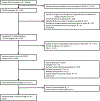Family Caregivers of Veterans Experience High Levels of Burden, Distress, and Financial Strain
- PMID: 32822072
- PMCID: PMC9677618
- DOI: 10.1111/jgs.16767
Family Caregivers of Veterans Experience High Levels of Burden, Distress, and Financial Strain
Abstract
Background/objectives: To describe the caregiving experiences and physical and emotional needs of family members and friends who provide care to veterans with mental, physical, and cognitive comorbidities.
Design: Cross-sectional study.
Setting: National telephone surveys administered from 2017 to 2019.
Participants: Family caregivers of veterans enrolled in the Veterans Affairs (VA) Program of General Caregiver Support Services between October 2016 and July 2018 who responded to a telephone survey (N = 1,509; response rate = 39%).
Measurements: We examined caregiver burden, depressive symptoms, financial strain, satisfaction with care, amount and duration of caregiving, life chaos, loneliness, and integration of caregiver with the healthcare team using validated instruments. We also collected caregiver demographic and socioeconomic characteristics and asked caregivers to identify the veteran's condition(s) and provide an assessment of the veteran's functioning.
Results: Average caregiver age was 62.2 (standard deviation [SD] = 13.7) and 69.8 (SD = 15.6) for veterans. Among caregivers, 76.7% identified at White, and 79.9% were married to the veteran. Caregivers reported having provided care for an average of 6.4 years and spending on average 9.6 hours per day and 6.6 days per week providing care. Average Zarit Subjective Burden score was 21.8 (SD = 9.4; range = 0-47), which is well above the cutoff for clinically significant burden (>16). Caregivers reported high levels of depressive symptoms; the sample average Center for Epidemiologic Studies Depression 10-item Scale score was 11.5 (SD = 7.1; range = 0-30). Caregivers also reported high levels of loneliness and financial strain.
Conclusion: Caregivers who care for veterans with trauma-based comorbidities reported intensive caregiving and significant levels of distress, depressive symptoms, and other negative consequences. These caregivers require comprehensive support services including access to health care, financial assistance, and enhanced respite care. Planned expansion of VA caregiver support has the potential to provide positive benefits for this population and serve as a model for caregiver support programs outside the VA health care system.
Keywords: caregiver; caregiver support; family caregiver; informal caregiver; veteran.
© 2020 The American Geriatrics Society.
Conflict of interest statement
Figures

References
-
- Committee on Family Caregiving for Older Adults; Board on Health Care Services; Health and Medicine Division; National Academies of Sciences, Engineering and Medicine. Families Caring for an Aging America. Washington, DC: National Academies Press; 2016. - PubMed
-
- Family Caregiver Alliance. Caregiver statistics: demographics. 2019. https://www.caregiver.org/caregiver-statistics-demographics. Accessed March 15, 2020.
-
- Van Houtven CH, Norton EC. Informal care and health care use of older adults. J Health Econ. 2004;23:1159–1180. - PubMed
-
- AARP Public Policy Institute; National Alliance for Caregiving. Caregiving in the U.S. 2015. https://www.aarp.org/content/dam/aarp/ppi/2015/caregiving-in-the-united-.... Accessed September 10, 2017.
Publication types
MeSH terms
Grants and funding
LinkOut - more resources
Full Text Sources

